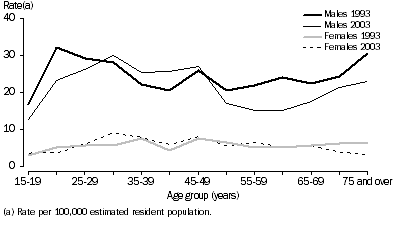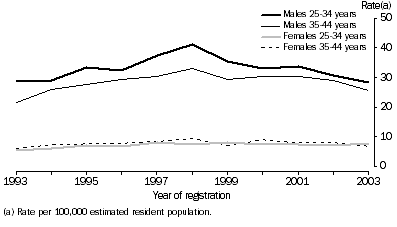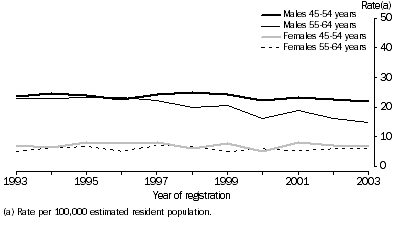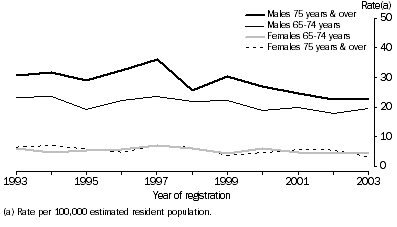NOTES
ABOUT THIS PUBLICATION
This publication presents summary statistics on deaths registered in Australia where the underlying cause of death was determined to be suicide. These statistics were compiled from data made available to the Australian Bureau of Statistics (ABS) by the Registrar of Births, Deaths and Marriages in each State or Territory. Data are presented for suicide deaths registered in the years 1993 to 2003, by sex and age group and method of suicide. State and territory death rates from suicide are also presented.
Tables of data referred to in the text are available in the pdf file which is available for purchase from this site.
INQUIRIES
For further information about these and related statistics, contact the National Information and Referral Service on 1300 135 070.
SUMMARY OF RESULTS
INTRODUCTION
Suicide continues to be a major public health issue. Although death by suicide is a relatively uncommon event (in 2003, 1.7% of all deaths registered were attributed to suicide), the human and economic costs are substantial. Suicide can be defined as the deliberate taking of one's life1. To be classified as a suicide a death must be recognised as being due to other than natural causes. It must also be established by coronial enquiry that the death resulted from a deliberate act of the deceased with the intention of ending his or her own life.
This publication contains summary statistics on deaths registered in Australia between 1993 and 2003 (the latest year for which data are available), where the underlying cause of death was determined as suicide. Data on deaths from suicide are presented disaggregated by sex, age, method of suicide and state or territory of usual residence. All data are presented by year of registration, rather than the year in which the death occurred. Most suicide deaths are registered in the same year in which the death occurred, or the year immediately following.
Changes in suicide numbers from year to year may be influenced by adminstrative processes involved in the coding of deaths. For example, where coronial investigations are not complete at the time of coding of causes of death, the intent is coded as accidental, and hence the death will not be counted as suicide. Some delays experienced in processing deaths for the 2003 registration year may have resulted in decreased numbers of registered deaths due to suicide. At least part of the decrease in numbers and rates for suicide in 2003 shown in this publication may be attributed to these factors.
OVERALL TRENDS
There were 2213 deaths from suicide registered in 2003. This number was a slight decrease from 2320 registered in the previous year.
Age standardisation allows comparison of rates between populations with different age structures. The age-standardised suicide rate (for persons) in 2003 was 6% lower than the corresponding rate for the previous year and 24% lower than the peak for the period 1993-2003, which occurred in 1997.
For males, in many age groups, there was a decline in age-specific suicide rates following peaks in the years 1997 and 1998. The age-standardised suicide rate for total males (17.7 per 100,000) in 2003 was lower than in any year in the previous decade (1993-2002).
Similarly for females, there were declines in rates for some age groups over this period and the age-standardised suicide rate for total females (4.7 per 100,000) in 2003 was the lowest since 1994.
Throughout the period 1993 to 2003 the male age-standardised suicide death rate was approximately four times higher than the corresponding female rate.
AGE-STANDARDISED DEATH RATES FOR SUICIDE

Number of deaths
When considering numbers of suicide deaths by age and sex in 1993 and 2003, it is clear that most suicide deaths occurred in males aged between 20 and 49 years. Changes in the age and sex distribution of suicide deaths over this period were evident (see graph below). Numbers of suicide deaths by age and sex for each year are presented in Table 1.
SUICIDE, NUMBER OF DEATHS, 1993 and 2003

Age-specific rates
The highest age-specific suicide death rate for both males and females in 2003 was observed in the 30-34 years age group (30.1 per 100,000 for males and 9.1 per 100,000 for females).
The lowest age-specific suicide death rate for males in 2003 was observed in the 15-19 years age group (12.7 per 100,000). For females low rates occurred in the 75 years and over age group and in the 15-24 years age group.
Rates for 1993 are also presented in the graph below for comparison. See also Table2
AGE-SPECIFIC SUICIDE RATES 1993 and 2003

SELECTED AGE GROUPS
The following section presents summary statistics for both males and females in selected age groups. In addition, graphs of selected age-specific rates are included to show trends over 1993-2003.
Age-specific rates are also presented in Tables 2 and 3. It is important to note that small numbers of suicide deaths in specific age and sex groups contribute to fluctuations in age-specific suicide death rates from year to year.
15-19 years age group
- In this age group, in 2003, suicide accounted for a total of 113 registered deaths, corresponding to age-specific rates of 12.7 for males, 3.6 for females and 8.3 per 100,000 for persons. This rate (for persons) was lower in 2003 than for any year in the previous decade (1993-2002).
- Suicide accounted for 19.9% of total male deaths and 13.1% of total female deaths registered in this age group, in 2003.
20-24 years age group
- In this age group, in 2003, suicide accounted for a total of 187 registered deaths, corresponding to age-specific rates of 23.3 for males, 3.7 for females and 13.7 per 100,000 for persons. This rate (for persons) was lower in 2003 than the corresponding rate for any year in the previous decade.
- Suicide accounted for 26.1% of total male deaths and 11.6% of total female deaths registered in this age group, in 2003.
AGE-SPECIFIC SUICIDE RATES

25-34 years age group
- In this age group, in 2003, suicide accounted for a total of 518 registered deaths, corresponding to age-specific rates of 28.3 for males, 7.7 for females and 18.0 per 100,000 for persons.
- Suicide accounted for 27.2% of total male deaths and 17.6% of total female deaths registered in this age group, in 2003.
35-44 years age group
- In this age group, in 2003, suicide accounted for a total of 483 registered deaths, corresponding to age-specific rates of 25.6 for males, 6.8 for females and 16.1 per 100,000 for persons.
- Suicide accounted for 16.5% of total male deaths and 8% of total female deaths registered in this age group, in 2003.
AGE-SPECIFIC SUICIDE RATES

45-54 years age group
- In this age group, in 2003, suicide accounted for a total of 392 registered deaths, corresponding to age-specific rates of 22.1 for males, 6.8 for females and 14.4 per 100,000 for persons.
- Suicide accounted for 7.4% of total male deaths and 3.7% of total female deaths registered in this age group, in 2003.
55-64 years age group
- In this age group, in 2003, suicide accounted for a total of 213 registered deaths, corresponding to age-specific rates of 15.0 for males, 5.9 for females and 10.5 per 100,000 for persons. This rate (for persons) was lower in 2003 than the corresponding rate for any year in the previous decade (1993-2002).
- Suicide accounted for 2% of total male deaths and 1.3% of total female deaths registered in this age group, in 2003.
AGE-SPECIFIC SUICIDE RATES

65-74 years age group
- In this age group, in 2003, suicide accounted for a total of 161 registered deaths, corresponding to age-specific rates of 19.4 for males, 4.7 for females and 11.9 per 100,000 for persons.
- Suicide accounted for less than 1% of total deaths registered in this age group, for both males and females, in 2003.
75 years and over age group
- In this age group, in 2003, suicide accounted for a total of 132 registered deaths, corresponding to age-specific rates of 22.9 for males, 3.2 for females and 11.1 per 100,000 for persons. This rate (for persons) was lower in 2003 than for any year in the previous decade (1993-2002).
- Suicide accounted for less than 1% of total deaths registered in this age group, for both males and females, in 2003.
AGE-SPECIFIC SUICIDE RATES

METHOD OF SUICIDE
In 2003 the most common method of suicide was hanging, which was used in almost half (45%) of all suicide deaths. The next most used methods were poisoning by 'other' (including motor vehicle exhaust) (19%), Other (15%), poisoning by drugs (13%), and methods using firearms (9%). This distribution was consistent with that of the previous few years. However, over the decade strong trends were apparent such as the increase in the use of hanging, and a decrease in methods using firearms. See Table 4 for data on broad groupings of method of suicide.
STATE AND TERRITORY
Suicide rates in states and territories may fluctuate over time particularly in the smaller jurisdictions because of the small number of suicides that may be registered annually. Therefore caution should be exercised when comparing annual state and territory suicide data (see Table 5). Other factors such as the ratio of urban to rural areas may also explain some of the differences across states and territories given the higher rates of suicide in rural areas. In addition, in the Northern Territory, the high rate of suicide in the Indigenous population contributes to the high rate of suicide in that jurisdiction.
Combining data for five years allows more reliable comparison of suicide rates across the states and territories. The following graph shows age-standardised suicide rates for the states and territories using the most recent five years of data (1999-2003) combined. Indirect standardisation (see glossary) was used to control for age and sex differences, allowing more valid comparisons across the states and territories. For this period, high rates were evident in the Northern Territory (77% above the national rate), followed by Tasmania (18% above the national rate) and Queensland (15% above the national rate). New South Wales, Victoria and the ACT all had rates lower than the national rate (see Table 5).
SUICIDE BY STATE AND TERRITORY 1999-2003, Standardised rates(a)

OTHER ABS PUBLICATIONS
Other ABS publications or articles that contain information on deaths from suicide are as follows:
Publications:
Causes of Death, Australia (cat. no. 3303.0) - annual
Deaths, Australia (cat. no. 3302.0) - annual
Suicides 1921-1998 (cat. no. 3309.0)
A Mortality Atlas of Australia (cat. no. 3318.0)
Trends in Mortality by Causes of Death in Australia, the States and Territories During 1971-92, and in Statistical Divisions and Sub-divisions During 1991-92 (cat. no. 3313.0)
Articles:
Suicide (Australian Social Trends 2000, cat. no. 4102.0)
Youth suicide (Australian Social Trends 1994, cat. no. 4102.0)
 Print Page
Print Page
 Print All
Print All